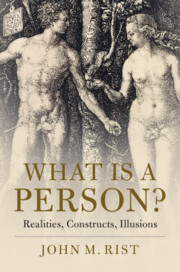Book contents
- What is a Person?
- What is a Person?
- Copyright page
- Contents
- Acknowledgments
- Introduction
- Part I Constructing the ‘Mainline Tradition’
- Part II No God, no Soul: What Person?
- 8 Virtue, ‘Virtue’, Rights
- 9 Descartes on Soul, Self, Mind, Nature
- 10 Personal Identity from Hobbes to Locke
- 11 After Locke
- 12 Sympathy or Empathy: Richardson, Hume, Smith
- 13 Ambiguous Rousseau’s Soul and ‘Moi’
- 14 Kant’s Rational Autonomy
- Part III Toward Disabling the Person
- Part IV Persons Restored or Final Solution?
- Epilogue or Epitaph?
- Appendix The World of Rights Transformed Again
- Bibliography
- Index
12 - Sympathy or Empathy: Richardson, Hume, Smith
from Part II - No God, no Soul: What Person?
Published online by Cambridge University Press: 05 December 2019
- What is a Person?
- What is a Person?
- Copyright page
- Contents
- Acknowledgments
- Introduction
- Part I Constructing the ‘Mainline Tradition’
- Part II No God, no Soul: What Person?
- 8 Virtue, ‘Virtue’, Rights
- 9 Descartes on Soul, Self, Mind, Nature
- 10 Personal Identity from Hobbes to Locke
- 11 After Locke
- 12 Sympathy or Empathy: Richardson, Hume, Smith
- 13 Ambiguous Rousseau’s Soul and ‘Moi’
- 14 Kant’s Rational Autonomy
- Part III Toward Disabling the Person
- Part IV Persons Restored or Final Solution?
- Epilogue or Epitaph?
- Appendix The World of Rights Transformed Again
- Bibliography
- Index
Summary
Help came from an unexpected quarter. Soon after Hutcheson’s work was published there appeared a series of novels of sentiment (‘sentimental’) from the pen of Samuel Richardson. They differed substantially from the earlier and more ‘libertine’ tales of Aphra Behn and Daniel Defoe and earned the contempt of Henry Fielding who offered alternatives in his own picaresque novels and parodied Richardson’s seemingly hypocritical Pamela in the person of his own blatantly hypocritical and immoral Shamela. Nevertheless, Richardson was directing the novel into new and very popular territory. In Pamela (1740) and Clarissa (1747–8) he highlights the moral and psychological dilemmas of very ordinary people, especially females. But his heroines are no longer the free-thinkers, libertines or whores – whether or not eventually penitent – of Behn and Defoe, but sweet – at times almost sugary – ‘nice’ people, hence to be read as moral exemplars by ordinary folk.
- Type
- Chapter
- Information
- What is a Person?Realities, Constructs, Illusions, pp. 117 - 129Publisher: Cambridge University PressPrint publication year: 2019

